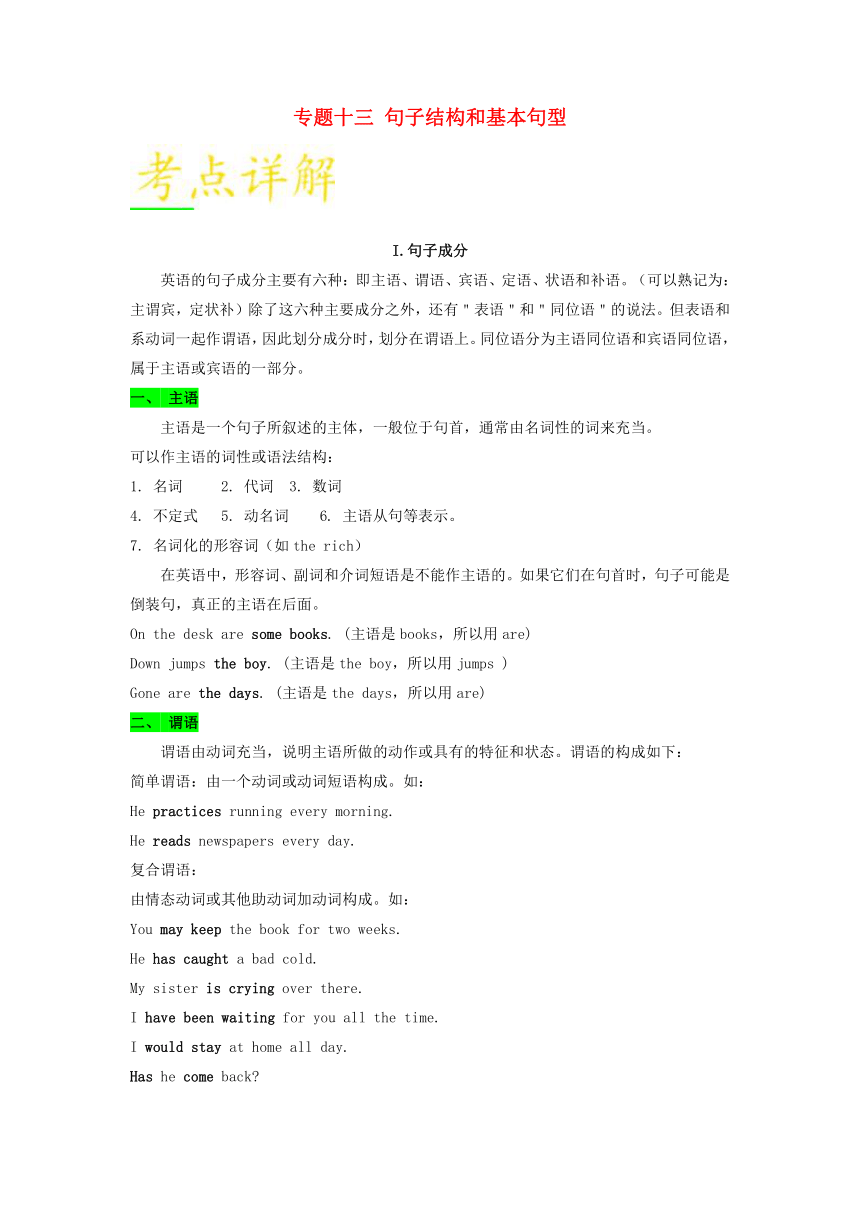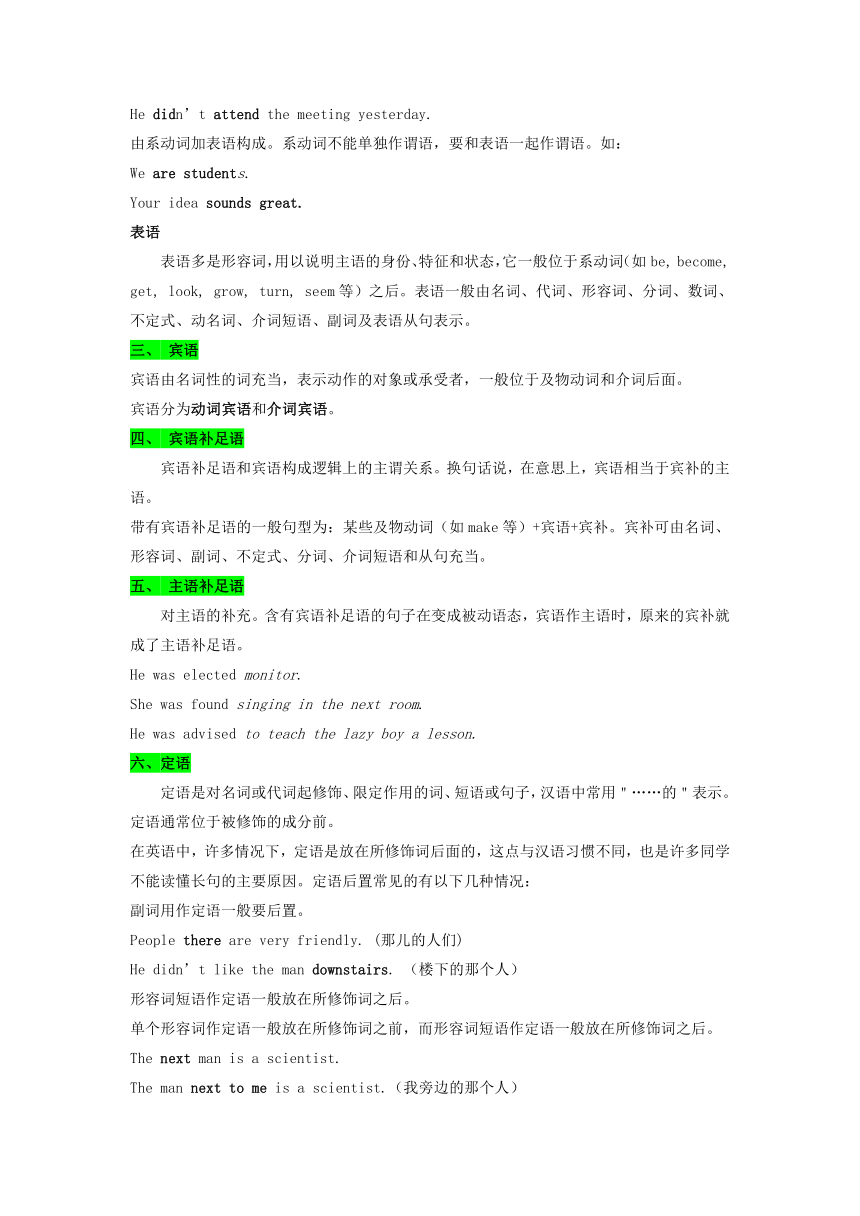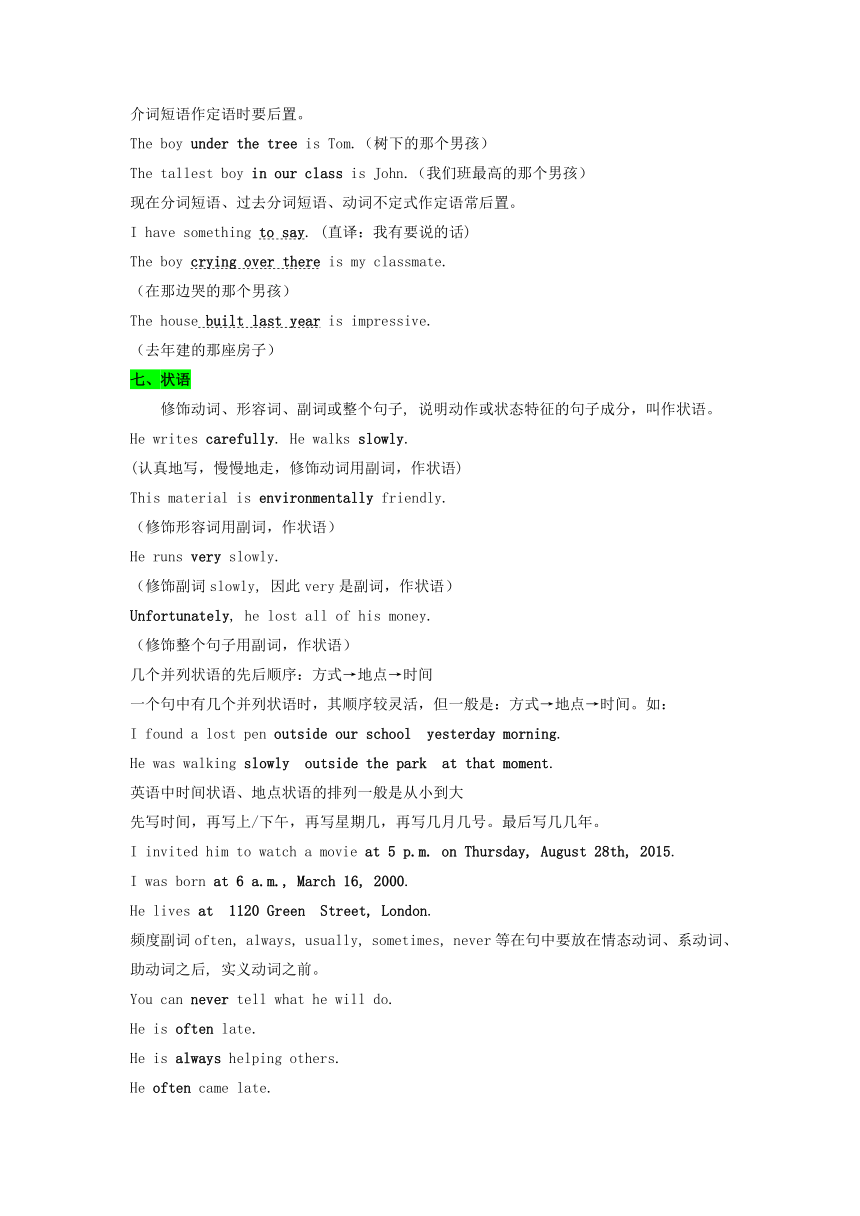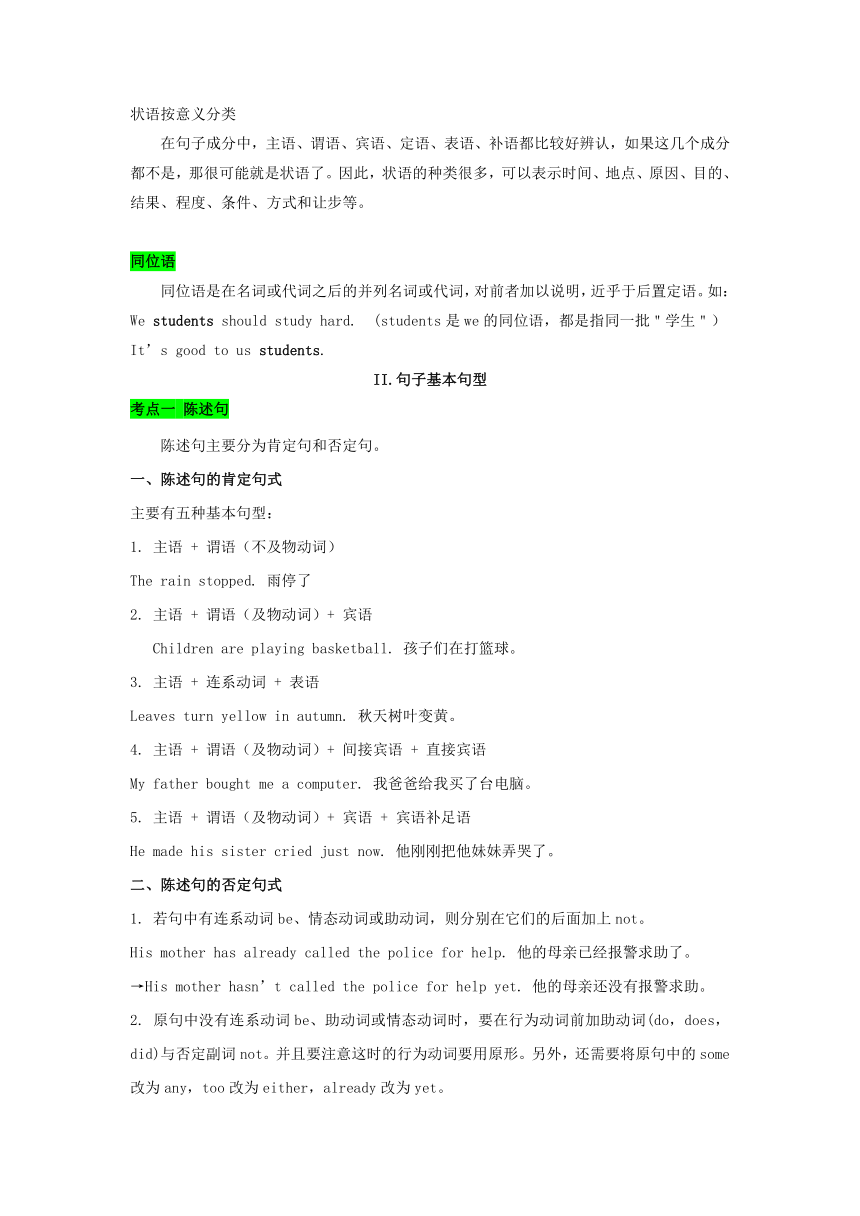2017高中英语语法句子结构和基本句型
文档属性
| 名称 | 2017高中英语语法句子结构和基本句型 |  | |
| 格式 | zip | ||
| 文件大小 | 895.7KB | ||
| 资源类型 | 教案 | ||
| 版本资源 | 人教版(新课程标准) | ||
| 科目 | 英语 | ||
| 更新时间 | 2017-11-07 23:03:19 | ||
图片预览





文档简介
专题十三
句子结构和基本句型
I.句子成分
英语的句子成分主要有六种:即主语、谓语、宾语、定语、状语和补语。(可以熟记为:主谓宾,定状补)除了这六种主要成分之外,还有"表语"和"同位语"的说法。但表语和系动词一起作谓语,因此划分成分时,划分在谓语上。同位语分为主语同位语和宾语同位语,属于主语或宾语的一部分。
一、
主语
主语是一个句子所叙述的主体,一般位于句首,通常由名词性的词来充当。
可以作主语的词性或语法结构:
1.
名词
2.
代词
3.
数词
4.
不定式
5.
动名词
6.
主语从句等表示。
7.
名词化的形容词(如the
rich)
在英语中,形容词、副词和介词短语是不能作主语的。如果它们在句首时,句子可能是倒装句,真正的主语在后面。
On
the
desk
are
some
books.
(主语是books,所以用are)
Down
jumps
the
boy.
(主语是the
boy,所以用jumps
)
Gone
are
the
days.
(主语是the
days,所以用are)
二、
谓语
谓语由动词充当,说明主语所做的动作或具有的特征和状态。谓语的构成如下:
简单谓语:由一个动词或动词短语构成。如:
He
practices
running
every
morning.
He
reads
newspapers
every
day.
复合谓语:
由情态动词或其他助动词加动词构成。如:
You
may
keep
the
book
for
two
weeks.
He
has
caught
a
bad
cold.
My
sister
is
crying
over
there.
I
have
been
waiting
for
you
all
the
time.
I
would
stay
at
home
all
day.
Has
he
come
back
He
didn’t
attend
the
meeting
yesterday.
由系动词加表语构成。系动词不能单独作谓语,要和表语一起作谓语。如:
We
are
students.
Your
idea
sounds
great.
表语
表语多是形容词,用以说明主语的身份、特征和状态,它一般位于系动词(如be,
become,
get,
look,
grow,
turn,
seem等)之后。表语一般由名词、代词、形容词、分词、数词、不定式、动名词、介词短语、副词及表语从句表示。
三、
宾语
宾语由名词性的词充当,表示动作的对象或承受者,一般位于及物动词和介词后面。
宾语分为动词宾语和介词宾语。
四、
宾语补足语
宾语补足语和宾语构成逻辑上的主谓关系。换句话说,在意思上,宾语相当于宾补的主语。
带有宾语补足语的一般句型为:某些及物动词(如make等)+宾语+宾补。宾补可由名词、形容词、副词、不定式、分词、介词短语和从句充当。
五、
主语补足语
对主语的补充。含有宾语补足语的句子在变成被动语态,宾语作主语时,原来的宾补就成了主语补足语。
He
was
elected
monitor.
She
was
found
singing
in
the
next
room.
He
was
advised
to
teach
the
lazy
boy
a
lesson.
六、定语
定语是对名词或代词起修饰、限定作用的词、短语或句子,汉语中常用"……的"表示。定语通常位于被修饰的成分前。
在英语中,许多情况下,定语是放在所修饰词后面的,这点与汉语习惯不同,也是许多同学不能读懂长句的主要原因。定语后置常见的有以下几种情况:
副词用作定语一般要后置。
People
there
are
very
friendly.
(那儿的人们)
He
didn’t
like
the
man
downstairs.
(楼下的那个人)
形容词短语作定语一般放在所修饰词之后。
单个形容词作定语一般放在所修饰词之前,而形容词短语作定语一般放在所修饰词之后。
The
next
man
is
a
scientist.
The
man
next
to
me
is
a
scientist.(我旁边的那个人)
介词短语作定语时要后置。
The
boy
under
the
tree
is
Tom.(树下的那个男孩)
The
tallest
boy
in
our
class
is
John.(我们班最高的那个男孩)
现在分词短语、过去分词短语、动词不定式作定语常后置。
I
have
something
to
say.
(直译:我有要说的话)
The
boy
crying
over
there
is
my
classmate.
(在那边哭的那个男孩)
The
house
built
last
year
is
impressive.
(去年建的那座房子)
七、状语
修饰动词、形容词、副词或整个句子,
说明动作或状态特征的句子成分,叫作状语。
He
writes
carefully.
He
walks
slowly.
(认真地写,慢慢地走,修饰动词用副词,作状语)
This
material
is
environmentally
friendly.
(修饰形容词用副词,作状语)
He
runs
very
slowly.
(修饰副词slowly,
因此very是副词,作状语)
Unfortunately,
he
lost
all
of
his
money.
(修饰整个句子用副词,作状语)
几个并列状语的先后顺序:方式→地点→时间
一个句中有几个并列状语时,其顺序较灵活,但一般是:方式→地点→时间。如:
I
found
a
lost
pen
outside
our
school
yesterday
morning.
He
was
walking
slowly
outside
the
park
at
that
moment.
英语中时间状语、地点状语的排列一般是从小到大
先写时间,再写上/下午,再写星期几,再写几月几号。最后写几几年。
I
invited
him
to
watch
a
movie
at
5
p.m.
on
Thursday,
August
28th,
2015.
I
was
born
at
6
a.m.,
March
16,
2000.
He
lives
at 1120
Green Street,
London.
频度副词often,
always,
usually,
sometimes,
never等在句中要放在情态动词、系动词、助动词之后,
实义动词之前。
You
can
never
tell
what
he
will
do.
He
is
often
late.
He
is
always
helping
others.
He
often
came
late.
状语按意义分类
在句子成分中,主语、谓语、宾语、定语、表语、补语都比较好辨认,如果这几个成分都不是,那很可能就是状语了。因此,状语的种类很多,可以表示时间、地点、原因、目的、结果、程度、条件、方式和让步等。
同位语
同位语是在名词或代词之后的并列名词或代词,对前者加以说明,近乎于后置定语。如:
We
students
should
study
hard.
(students是we的同位语,都是指同一批"学生")
It’s
good
to
us
students.
II.句子基本句型
考点一
陈述句
陈述句主要分为肯定句和否定句。
一、陈述句的肯定句式
主要有五种基本句型:
1.
主语
+
谓语(不及物动词)
The
rain
stopped.
雨停了
2.
主语
+
谓语(及物动词)+
宾语
Children
are
playing
basketball.
孩子们在打篮球。
3.
主语
+
连系动词
+
表语
Leaves
turn
yellow
in
autumn.
秋天树叶变黄。
4.
主语
+
谓语(及物动词)+
间接宾语
+
直接宾语
My
father
bought
me
a
computer.
我爸爸给我买了台电脑。
5.
主语
+
谓语(及物动词)+
宾语
+
宾语补足语
He
made
his
sister
cried
just
now.
他刚刚把他妹妹弄哭了。
二、陈述句的否定句式
1.
若句中有连系动词be、情态动词或助动词,则分别在它们的后面加上not。
His
mother
has
already
called
the
police
for
help.
他的母亲已经报警求助了。
→His
mother
hasn’t
called
the
police
for
help
yet.
他的母亲还没有报警求助。
2.
原句中没有连系动词be、助动词或情态动词时,要在行为动词前加助动词(do,does,did)与否定副词not。并且要注意这时的行为动词要用原形。另外,还需要将原句中的some改为any,too改为either,already改为yet。
The
old
man
hurt
his
leg
last
Wednesday.
这位老人上周三腿受伤了。
→The
old
man
didn’t
hurt
his
leg
last
Wednesday.
这位老人上周三腿没有受伤。
3.
英语中有些肯定句与not连用只表示部分否定,所以在变为否定句时,只需将其中的某一(些)词语变为否定词即可。常见的这类词有both→neither,all→none,both...
and...
→neither...
nor...,everyone/each→no
one/nobody,each/either→neither,a
few→few,a
little→little。
All
the
students
are
listening
carefully.
→None
of
the
students
is/are
listening
carefully.
Both
Joy
and
Sam
like
singing
Beijing
Opera.
→Neither
Joy
nor
Sam
likes
singing
Beijing
Opera.
考点二
疑问句
一、一般疑问句
英语中的疑问句分为一般疑问句、特殊疑问句、选择疑问句和反意疑问句四种。所谓一般疑问句,就是可以用yes或no来回答的疑问句。
1.
肯定形式的一般疑问句
此类一般疑问句的结构为"连系动词be/助动词/情态动词
+
主语
+
动词原形
+
其他
"。
—Is
he
a
good
student
他是一个好学生吗
—Yes,
he
is.
是的,他是。/
No,
he
isn’t.
不,他不是。
—Does
he
go
to
school
by
bike
他骑自行车去上学吗
—Yes,
he
does.
是的,他骑。/
No,
he
doesn’t.
不,他不骑。
—Do
you
have
anything
good
to
suggest
—____________.
If
I
have,
I
will
put
it
on
the
QQ
message.
A.
Yes,
I
have
B.
No,
I
haven’t
C.
Yes,
I
do
D.
No,
I
don’t
【参考答案】D
【详细解析】句意:——你有什么好的建议吗
——没有。如果有的话,我就给你QQ留言。根据句意可知,用No作否定回答,另外,have是实义动词,回答时要借助于助动词do,即No,I
don’t,故选D。
2.
否定形式的一般疑问句
此类一般疑问句主要表示反问或惊讶,通常在连系动词be,情态动词或助动词后加not的缩略式n’t,并放在句首。
—Aren’t
you
a
writer
难道你不是作家吗?
—No,
I’m
not.
是的,我不是。
【注意】在这样的句子中,要注意句子的翻译,yes翻译成"不",no翻译成"是的"。
3.
用yes,no之外的词回答的一般疑问句
一般疑问句也可用其他表示肯定或否定的词回答,如:certainly,sure,of
course,I
think
so,all
right,certainly
not,not
at
all,never,sorry,not
yet,I’m
afraid
not等。
—Would
you
mind
my
joining
your
talk
我加入你们的讨论,你们介意吗?
—Of
course
not.
当然不介意。
—Would
you
please
help
me
with
my
writing
skills
—____________.
You
can
come
to
my
office
every
Saturday.
A.
That’s
all
right
B.
Not
at
all
C.
No
problem
D.
No,
thanks
【参考答案】C
【详细解析】That’s
all
right"没关系";Not
at
all"不用谢";No
problem"没问题";No,thanks"不,谢谢"。根据You
can
come
to
my
office
every
Saturday.
可知"可以帮忙"。故选C。
二、特殊疑问句
以疑问词开头的疑问句叫特殊疑问句。特殊疑问句的基本结构是"疑问词
+
一般疑问句"。常见的疑问词有what,who,whose,which,when,where,how,what
time,what
color,how
much,how
many,how
long,how
often,how
soon等。
1.
特殊疑问句的语序
疑问词作主语时,句子的语序与陈述句的语序相同。当疑问词作句子的宾语、状语等时,应用"疑问词
+
一般疑问句"结构。
Who
will
give
us
a
talk
谁将给我们做报告?(who作主语)
When
do
you
get
up
every
day
你每天什么时候起床?(when作时间状语)
2.
否定形式的特殊疑问句
否定形式的特殊疑问句由"疑问词
+
一般疑问句的否定形式"构成,主要表示劝告、建议或责备等。
Why
didn’t
you
tell
me
earlier
你为什么不早点告诉我呢?
When
can’t
he
come
他什么时候不能来?
3.
对画线部分提问
这类题实际上就是将所给的陈述句变为特殊疑问句。解这类题时通常分三步完成:首先选准疑问词;然后改为疑问句语序;最后抄写剩余的部分。当对句子的主语提问时,其语序是"疑问词
+
谓语
+
其他成分
"。
Jack
is
over
there.
→Who
is
over
there
He
comes
to
China
once
a
year.
→How
often
does
he
come
to
China
三、选择疑问句
要求对方对两种或两种以上的情况进行选择的问句叫选择疑问句。选择疑问句的最后两个供选择部分用or连接。选择疑问句有两种:一般选择疑问句和特殊选择疑问句。
—Do
you
like
Tom
or
Jerry
你喜欢汤姆还是杰瑞?
—I
like
Jerry.
我喜欢杰瑞。
—Which
do
you
like
best,
apples,
oranges
or
bananas
你最喜欢哪样,苹果、橘子还是香蕉
—I
like
apples
best.
我最喜欢苹果。
【注意】选择疑问句不能用yes或no来回答。
四、反意疑问句
1.
反意疑问句的特点
反意疑问句是由两部分构成的:前一部分是对事物的陈述,后一部分是简短的提问。即"陈述句
+
附加疑问句"。反意疑问句前后两部分必须遵循的原则是"三同一反",即:人称相同,动词相同,时态相同,前肯后否,前否后肯。
Mary
is
a
worker,
isn’t
she
玛丽是工人,是不是?
You
won’t
go
to
the
Summer
Palace
tomorrow,
will
you
明天你不去颐和园,是吗?
2.
反意疑问句的答语
对反意疑问句的回答,不管问题的提法如何,若事实是肯定的,就用yes回答;若事实是否定的,就用no回答。注意在"前否后肯"的反意疑问句的答语中,yes意为"不",no意为"是"。
—He
isn’t
going
to
the
meeting,
is
he
他不去参加会议,是吗?
—Yes,
he
is.
不,他要去。/
No,
he
isn’t.
对,他不去。
3.
常考的反意疑问句
(1)当陈述部分的主语是I,而句子又用来征询对方的意见时,附加疑问句中的主语用you。如:
I
find
English
very
interesting,
don’t
you
I
don’t
like
that
film,
do
you
(2)当陈述部分的主语是everybody,
everyone,
someone,
nobody,
no
one,
somebody等合成代词时,附加疑问句中的主语通常用they。但亦可用he,尤其是nobody,
no
one等作主语,具有否定概念时。如:
Somebody
phoned
while
I
was
out,
didn’t
they
Everyone
enjoyed
the
party,
didn’t
they
Nobody
wants
to
go
there,
does
he
(3)
当陈述部分的主语是不定代词everything,
nothing,
anything,
something时,附加
疑问句中的主语一般用it,不用they。如:
Everything
seems
all
right
now,
doesn’t
it
Nothing
is
kept
in
good
order,
is
it
Something
must
be
done
to
stop
pollution,
isn’t
it
(4)
当陈述部分的主语是指示代词this,
that或these,
those时,附加疑问句中的主语分别用it和they。如:
This
is
important,
isn’t
it
That
isn’t
correct,
is
it
These
are
your
friends
Tom
and
Jack,
aren’t
they
(5)如果陈述部分是以代词one作主语,附加疑问句中的主语在正式场合用one,非正式场合用you,在美国英语中,在非正式场合还可以用he。如:
One
can’t
be
too
careful,
can
one 或can
you
One
should
do
his
duty,
shouldn’t
he
(6)如果陈述部分用I’m…结构,附加疑问部分一般用aren’t
I。如:
I
am
strong
and
healthy
aren’t
I。
7.当陈述句为there
be结构时,附加疑问句中的主语也用there。如:
There’s
no
help
for
it,
is
there
There’s
something
wrong,
isn’t
there
(8)陈述部分带有seldom,
hardly,
never,
rarely,
few,
little,nowhere,
nothing等否定词或半否定词时,附加疑问部分的动词用肯定形式。如:
Bob
rarely
got
drunk,
did
he
Few
people
know
him,
do
they
She
seldom
goes
to
the
cinema,
does
she
如果陈述部分的否定词带有否定前缀,那么,该陈述部分作肯定处理,附加疑问部分一般仍用否定形式。如:
He
was
unsuccessful,
wasn’t
he
Tom
dislikes
the
book,
doesn’t
he
(9)当陈述部分为主从复合句时,附加疑问部分一般应与主句的主语和谓语动词保持对应关系。如:
She
says
that
I
did
it,
doesn’t
she
I
told
them
not
everybody
could
do
it
,didn’t
I
但当陈述部分的主语是I,谓语是think,
believe,
suppose,
expect这类动词时,附加疑问部分则往往与从句中的主语和谓语动词保持对应关系,但要注意否定的转移。
I
suppose
that
he’s
serious
isn’t
he
I
don’t
think
she
cares,
does
she
(10)当陈述部分是并列句,附加疑问句则需和就近的分句的主语和谓语一致。如:
Xiao
Lin
has
been
writing
letters
all
afternoon
but
he
should
finish
them
now,
shouldn’t
he
(11)在由“祈使句+附加疑问”构成的附加疑问句中,附加疑问部分一般用will
you,
won’t
you,
would
you,有时也可用can
you,
can’t
you,
why
don’t
you,
could
you等。如:
Don’t
open
the
door,
will
you
Give
me
some
cigarettes,
can
you
Take
a
rest,
why
don’t
you
但是,以let’s开头的祈使句,附加疑问部分用shall
we;以let
us开头的祈使句,如果含义是allow
us,不包括听话人在内,疑问部分用will
you。如:
Let’s
have
a
basketball
match
this
afternoon,
shall
we
Let
us
go
out
for
a
rest,
will
you
(12)当陈述部分带有情态动词must表示“必须”时,疑问部分用mustn’t。如:
You
must
work
hard
next
term,
mustn’t
you
I
must
answer
the
letter,
mustn’t
I
但若表推测这层含义时,不能用must,而要根据陈述部分的不定式结构(即must之后的动词)以及含义采用相应的动词形式。如:
You
must
have
made
a
mistake,
haven’t
you
They
must
have
seen
the
film
last
week,
didn’t
they
He
must
be
in
the
library,
isn’t
he
(13)当陈述部分含有情态动词used
to时,疑问部分可用usedn’t或didn’t。如:
The
old
man
used
to
smoke,
didn’t
he 或usedn’t
he
Tom
used
to
live
here,
usedn’t
he 或didn’t
he
(14)
当陈述部分带有情态动词ought
to时,疑问部分用oughtn’t或shouldn’t。如:
He
ought
to
know
the
answer,
oughtn’t
he
We
ought
to
read
this
book,
oughtn’t
we 或shouldn’t
we
(15)当陈述部分含有had
better时,疑问部分用had。
如:?You’d
better
finish
your
homework
now,
hadn’t
you
(16)感叹句后的附加疑问句的谓语动词需用be的现在时,且常用否定形式。如:
What
a
clever
boy,
isn’t
he
What
a
lovely
day,
isn’t
it
(17)陈述句子中的主语为动词不定式短语、动名词短语或其他短语时,疑问部分的主语通常用it。如:
Learning
how
to
repair
motors
takes
a
long
time,
doesn’t
it
Between
six
and
seven
will
suit
you,
won’t
it
Where
to
hold
the
meeting
has
not
been
decided,
has
it
(18)在口语和非正式文体中,为了加强语气,只是表示某种惊奇、怀疑、反感、讽刺等感情而并不是为了寻求回答,这时前后两部分的肯定、否定是一致的。如:
Oh,
he
is
a
writer,
is
he
You’ll
not
go,
won’t
you
(2014·重庆)
—I
spent
two
weeks
in
London
last
summer.
—
Then
you
must
have
visited
the
British
Museum
during
your
stay,
_______
you
A.
mustn’t
B.
haven’t
C.
didn’t
D.
hadn’t
【参考答案】C
【详细解析】题意:逗留伦敦期间肯定去看过大英博物馆。题中last
summer表示的是一个确定的过去时间,可认定must
have
visited是对"过去"的推断。故C项正确。
考点三
感叹句
一、感叹句的基本用法
用来表示说话人强烈的喜、怒、哀、乐等感情的句子,叫感叹句。感叹句由what或how引导,具体用法如下表:
类别
结构
例句
what引导
What
+
a/an
+
形容词
+
单数可数名词(+
主语
+
谓语)!
What
a
kind
girl
(
she
is
)!
(她是)一个多么善良的女孩啊!
What
+
形容词
+
复数可数名词/不可数名词(+
主语
+
谓语)!
What
beautiful
flowers
(
they
are)!
多么漂亮的花!What
bad
weather
(
it
is
)!
多么糟糕的天气!
how引导
How
+
主语
+
谓语!
How
time
flies!
时间飞逝!
How
+
形容词/副词(+
主语
+
谓语)!
How
brave
(
the
hero
is
)!(这个英雄)真勇敢!How
slowly
he
walks!
他走得多慢啊!
How
+
形容词
+
a/an
+
单数可数名词(+
主语
+
谓语)!
How
clever
(
a
boy
he
is
)!
(他是)一个多么聪明的男孩啊!
1.
____________
exciting
news!
We’ve
never
had
____________
long
vacation
before.
A.
What;such
a
B.
What
an;such
a
C.
How;such
a
D.
What;so
【参考答案】A
【详细解析】句意:多么令人兴奋的消息!
以前我们从来没有这么长的假期。此题考查"What
+
adj.
+
名词!
"和"such
a
+
adj.
+
名词"结构。故选A。
二、陈述句改感叹句
陈述句变为感叹句时,常使用"一断二加三换位"的方法:
1.
"一断",即在谓语后边断开,使句子分为两部分。
She
is
‖
a
beautiful
girl.
她是一位美丽的姑娘。
He
works
‖
hard.
他工作努力。
2.
"二加",即如果第二部分为副词、形容词,就加上how;如果是一个名词(词组),就加上what。
She
is
‖
(what)
a
beautiful
girl.
He
works
‖
(how)
hard.
3.
"三换位",即把第一部分与第二部分互换位置,同时把句号换为感叹号。
What
a
beautiful
girl
she
is!
How
hard
he
works!
感叹句记忆口诀感叹句,并不难,what与how应在前。形容词、副词跟着how,what后面名词连。名词若是可数单,前带冠词a或an。主语、谓语放后面,省略它们也常见
基础过关
I.完成句子
1.These
days,______________are
not
uncommon,causing
serious
harm
to
life
and
the
environment.
最近,违反交通规则和乱丢垃圾已是司空见惯,给人们的生活和环境都带来了严重的危害。
2.
Since
then,math________________,and
I
have
also
made
rapid
progress
in
it.
从那时起,数学成了我最喜欢的学科之一,并且我在数学上也取得了巨大的进步。
3.To
learn
English
well,we
should
find
opportunities________________.
为了学好英语,我们应该尽可能多地找听英语的机会。
4.________________,I
became
the
focus
of
the
whole
class
and
was
full
of
great
pride
and
confidence.
在那一时刻,我成为全班的焦点,充满了骄傲和自信。
5.I
think,good
books
are________________to
students.
我认为好书对学生非常有价值。
II.根据汉语提示完成句子
1.This
kind
of
cloth________.
这种布料摸起来很软。
2.They
haven’t
decided________________again.
他们尚未决定什么时候再讨论这个问题。
3.Granny
told________________last
night.
奶奶昨晚给我讲了一个有趣的故事。
4.Every
morning
we
hear
him________________.
每天早上我们都能听到他大声朗读英语。
5.People________________since
ancient
times.
从古代起,人们就把早起视为好习惯。
6.________________in
my
hometown
in
the
past
ten
years.
在过去的十年中我的家乡发生了巨大变化。
7.You
will
find________________to
so
much
knowledge.
你会发现英语是通往如此丰富知识的桥梁。
8.I
really________________to
help
me
with
my
math.
我真的很感谢你过来帮我学习数学。
9.Nowadays,people
in
many
big
cities________________.
当今,许多大城市的人们在抱怨交通拥堵。
10.First,he________________and
skills
of
making
dough
figurines.
首先他向我们展示了制作面人的基本步骤和技巧。
体验真题
(2013·湖南)
Do
not
let
any
failures
discourage
you,
for
you
can
never
tell
________
close
you
may
be
to
victory.
A.
how
B.
that
C.
which
D.
where
基础过关
I.完成句子
1.breaking
traffic
rules
and
littering
2.has
become
one
of
my
favorite
subjects
3.to
hear
English
spoken
as
much
as
possible
4.At
that
moment
5.valuable/of
great
value
II.根据汉语提示完成句子
1.feels
soft
2.when
to
discuss
the
problem
3.me
a
very
interesting
story
4.read
English
aloud
5.have
regarded
getting
up
early
as
a
good
habit
6.Great
changes
have
taken
place
7.English
a
bridge
8.appreciate
your
coming
over
9.are
complaining
about
traffic
jams
10.showed
us
the
basic
steps
体验真题
A 【解析】句意:别让失败弄得你垂头丧气,因为你永远不知道你离胜利有多么近。及物动词tell后接宾语从句,该宾语从句本身又是一个感叹句;修饰形容词close用how。
句子结构和基本句型
I.句子成分
英语的句子成分主要有六种:即主语、谓语、宾语、定语、状语和补语。(可以熟记为:主谓宾,定状补)除了这六种主要成分之外,还有"表语"和"同位语"的说法。但表语和系动词一起作谓语,因此划分成分时,划分在谓语上。同位语分为主语同位语和宾语同位语,属于主语或宾语的一部分。
一、
主语
主语是一个句子所叙述的主体,一般位于句首,通常由名词性的词来充当。
可以作主语的词性或语法结构:
1.
名词
2.
代词
3.
数词
4.
不定式
5.
动名词
6.
主语从句等表示。
7.
名词化的形容词(如the
rich)
在英语中,形容词、副词和介词短语是不能作主语的。如果它们在句首时,句子可能是倒装句,真正的主语在后面。
On
the
desk
are
some
books.
(主语是books,所以用are)
Down
jumps
the
boy.
(主语是the
boy,所以用jumps
)
Gone
are
the
days.
(主语是the
days,所以用are)
二、
谓语
谓语由动词充当,说明主语所做的动作或具有的特征和状态。谓语的构成如下:
简单谓语:由一个动词或动词短语构成。如:
He
practices
running
every
morning.
He
reads
newspapers
every
day.
复合谓语:
由情态动词或其他助动词加动词构成。如:
You
may
keep
the
book
for
two
weeks.
He
has
caught
a
bad
cold.
My
sister
is
crying
over
there.
I
have
been
waiting
for
you
all
the
time.
I
would
stay
at
home
all
day.
Has
he
come
back
He
didn’t
attend
the
meeting
yesterday.
由系动词加表语构成。系动词不能单独作谓语,要和表语一起作谓语。如:
We
are
students.
Your
idea
sounds
great.
表语
表语多是形容词,用以说明主语的身份、特征和状态,它一般位于系动词(如be,
become,
get,
look,
grow,
turn,
seem等)之后。表语一般由名词、代词、形容词、分词、数词、不定式、动名词、介词短语、副词及表语从句表示。
三、
宾语
宾语由名词性的词充当,表示动作的对象或承受者,一般位于及物动词和介词后面。
宾语分为动词宾语和介词宾语。
四、
宾语补足语
宾语补足语和宾语构成逻辑上的主谓关系。换句话说,在意思上,宾语相当于宾补的主语。
带有宾语补足语的一般句型为:某些及物动词(如make等)+宾语+宾补。宾补可由名词、形容词、副词、不定式、分词、介词短语和从句充当。
五、
主语补足语
对主语的补充。含有宾语补足语的句子在变成被动语态,宾语作主语时,原来的宾补就成了主语补足语。
He
was
elected
monitor.
She
was
found
singing
in
the
next
room.
He
was
advised
to
teach
the
lazy
boy
a
lesson.
六、定语
定语是对名词或代词起修饰、限定作用的词、短语或句子,汉语中常用"……的"表示。定语通常位于被修饰的成分前。
在英语中,许多情况下,定语是放在所修饰词后面的,这点与汉语习惯不同,也是许多同学不能读懂长句的主要原因。定语后置常见的有以下几种情况:
副词用作定语一般要后置。
People
there
are
very
friendly.
(那儿的人们)
He
didn’t
like
the
man
downstairs.
(楼下的那个人)
形容词短语作定语一般放在所修饰词之后。
单个形容词作定语一般放在所修饰词之前,而形容词短语作定语一般放在所修饰词之后。
The
next
man
is
a
scientist.
The
man
next
to
me
is
a
scientist.(我旁边的那个人)
介词短语作定语时要后置。
The
boy
under
the
tree
is
Tom.(树下的那个男孩)
The
tallest
boy
in
our
class
is
John.(我们班最高的那个男孩)
现在分词短语、过去分词短语、动词不定式作定语常后置。
I
have
something
to
say.
(直译:我有要说的话)
The
boy
crying
over
there
is
my
classmate.
(在那边哭的那个男孩)
The
house
built
last
year
is
impressive.
(去年建的那座房子)
七、状语
修饰动词、形容词、副词或整个句子,
说明动作或状态特征的句子成分,叫作状语。
He
writes
carefully.
He
walks
slowly.
(认真地写,慢慢地走,修饰动词用副词,作状语)
This
material
is
environmentally
friendly.
(修饰形容词用副词,作状语)
He
runs
very
slowly.
(修饰副词slowly,
因此very是副词,作状语)
Unfortunately,
he
lost
all
of
his
money.
(修饰整个句子用副词,作状语)
几个并列状语的先后顺序:方式→地点→时间
一个句中有几个并列状语时,其顺序较灵活,但一般是:方式→地点→时间。如:
I
found
a
lost
pen
outside
our
school
yesterday
morning.
He
was
walking
slowly
outside
the
park
at
that
moment.
英语中时间状语、地点状语的排列一般是从小到大
先写时间,再写上/下午,再写星期几,再写几月几号。最后写几几年。
I
invited
him
to
watch
a
movie
at
5
p.m.
on
Thursday,
August
28th,
2015.
I
was
born
at
6
a.m.,
March
16,
2000.
He
lives
at 1120
Green Street,
London.
频度副词often,
always,
usually,
sometimes,
never等在句中要放在情态动词、系动词、助动词之后,
实义动词之前。
You
can
never
tell
what
he
will
do.
He
is
often
late.
He
is
always
helping
others.
He
often
came
late.
状语按意义分类
在句子成分中,主语、谓语、宾语、定语、表语、补语都比较好辨认,如果这几个成分都不是,那很可能就是状语了。因此,状语的种类很多,可以表示时间、地点、原因、目的、结果、程度、条件、方式和让步等。
同位语
同位语是在名词或代词之后的并列名词或代词,对前者加以说明,近乎于后置定语。如:
We
students
should
study
hard.
(students是we的同位语,都是指同一批"学生")
It’s
good
to
us
students.
II.句子基本句型
考点一
陈述句
陈述句主要分为肯定句和否定句。
一、陈述句的肯定句式
主要有五种基本句型:
1.
主语
+
谓语(不及物动词)
The
rain
stopped.
雨停了
2.
主语
+
谓语(及物动词)+
宾语
Children
are
playing
basketball.
孩子们在打篮球。
3.
主语
+
连系动词
+
表语
Leaves
turn
yellow
in
autumn.
秋天树叶变黄。
4.
主语
+
谓语(及物动词)+
间接宾语
+
直接宾语
My
father
bought
me
a
computer.
我爸爸给我买了台电脑。
5.
主语
+
谓语(及物动词)+
宾语
+
宾语补足语
He
made
his
sister
cried
just
now.
他刚刚把他妹妹弄哭了。
二、陈述句的否定句式
1.
若句中有连系动词be、情态动词或助动词,则分别在它们的后面加上not。
His
mother
has
already
called
the
police
for
help.
他的母亲已经报警求助了。
→His
mother
hasn’t
called
the
police
for
help
yet.
他的母亲还没有报警求助。
2.
原句中没有连系动词be、助动词或情态动词时,要在行为动词前加助动词(do,does,did)与否定副词not。并且要注意这时的行为动词要用原形。另外,还需要将原句中的some改为any,too改为either,already改为yet。
The
old
man
hurt
his
leg
last
Wednesday.
这位老人上周三腿受伤了。
→The
old
man
didn’t
hurt
his
leg
last
Wednesday.
这位老人上周三腿没有受伤。
3.
英语中有些肯定句与not连用只表示部分否定,所以在变为否定句时,只需将其中的某一(些)词语变为否定词即可。常见的这类词有both→neither,all→none,both...
and...
→neither...
nor...,everyone/each→no
one/nobody,each/either→neither,a
few→few,a
little→little。
All
the
students
are
listening
carefully.
→None
of
the
students
is/are
listening
carefully.
Both
Joy
and
Sam
like
singing
Beijing
Opera.
→Neither
Joy
nor
Sam
likes
singing
Beijing
Opera.
考点二
疑问句
一、一般疑问句
英语中的疑问句分为一般疑问句、特殊疑问句、选择疑问句和反意疑问句四种。所谓一般疑问句,就是可以用yes或no来回答的疑问句。
1.
肯定形式的一般疑问句
此类一般疑问句的结构为"连系动词be/助动词/情态动词
+
主语
+
动词原形
+
其他
"。
—Is
he
a
good
student
他是一个好学生吗
—Yes,
he
is.
是的,他是。/
No,
he
isn’t.
不,他不是。
—Does
he
go
to
school
by
bike
他骑自行车去上学吗
—Yes,
he
does.
是的,他骑。/
No,
he
doesn’t.
不,他不骑。
—Do
you
have
anything
good
to
suggest
—____________.
If
I
have,
I
will
put
it
on
the
message.
A.
Yes,
I
have
B.
No,
I
haven’t
C.
Yes,
I
do
D.
No,
I
don’t
【参考答案】D
【详细解析】句意:——你有什么好的建议吗
——没有。如果有的话,我就给你QQ留言。根据句意可知,用No作否定回答,另外,have是实义动词,回答时要借助于助动词do,即No,I
don’t,故选D。
2.
否定形式的一般疑问句
此类一般疑问句主要表示反问或惊讶,通常在连系动词be,情态动词或助动词后加not的缩略式n’t,并放在句首。
—Aren’t
you
a
writer
难道你不是作家吗?
—No,
I’m
not.
是的,我不是。
【注意】在这样的句子中,要注意句子的翻译,yes翻译成"不",no翻译成"是的"。
3.
用yes,no之外的词回答的一般疑问句
一般疑问句也可用其他表示肯定或否定的词回答,如:certainly,sure,of
course,I
think
so,all
right,certainly
not,not
at
all,never,sorry,not
yet,I’m
afraid
not等。
—Would
you
mind
my
joining
your
talk
我加入你们的讨论,你们介意吗?
—Of
course
not.
当然不介意。
—Would
you
please
help
me
with
my
writing
skills
—____________.
You
can
come
to
my
office
every
Saturday.
A.
That’s
all
right
B.
Not
at
all
C.
No
problem
D.
No,
thanks
【参考答案】C
【详细解析】That’s
all
right"没关系";Not
at
all"不用谢";No
problem"没问题";No,thanks"不,谢谢"。根据You
can
come
to
my
office
every
Saturday.
可知"可以帮忙"。故选C。
二、特殊疑问句
以疑问词开头的疑问句叫特殊疑问句。特殊疑问句的基本结构是"疑问词
+
一般疑问句"。常见的疑问词有what,who,whose,which,when,where,how,what
time,what
color,how
much,how
many,how
long,how
often,how
soon等。
1.
特殊疑问句的语序
疑问词作主语时,句子的语序与陈述句的语序相同。当疑问词作句子的宾语、状语等时,应用"疑问词
+
一般疑问句"结构。
Who
will
give
us
a
talk
谁将给我们做报告?(who作主语)
When
do
you
get
up
every
day
你每天什么时候起床?(when作时间状语)
2.
否定形式的特殊疑问句
否定形式的特殊疑问句由"疑问词
+
一般疑问句的否定形式"构成,主要表示劝告、建议或责备等。
Why
didn’t
you
tell
me
earlier
你为什么不早点告诉我呢?
When
can’t
he
come
他什么时候不能来?
3.
对画线部分提问
这类题实际上就是将所给的陈述句变为特殊疑问句。解这类题时通常分三步完成:首先选准疑问词;然后改为疑问句语序;最后抄写剩余的部分。当对句子的主语提问时,其语序是"疑问词
+
谓语
+
其他成分
"。
Jack
is
over
there.
→Who
is
over
there
He
comes
to
China
once
a
year.
→How
often
does
he
come
to
China
三、选择疑问句
要求对方对两种或两种以上的情况进行选择的问句叫选择疑问句。选择疑问句的最后两个供选择部分用or连接。选择疑问句有两种:一般选择疑问句和特殊选择疑问句。
—Do
you
like
Tom
or
Jerry
你喜欢汤姆还是杰瑞?
—I
like
Jerry.
我喜欢杰瑞。
—Which
do
you
like
best,
apples,
oranges
or
bananas
你最喜欢哪样,苹果、橘子还是香蕉
—I
like
apples
best.
我最喜欢苹果。
【注意】选择疑问句不能用yes或no来回答。
四、反意疑问句
1.
反意疑问句的特点
反意疑问句是由两部分构成的:前一部分是对事物的陈述,后一部分是简短的提问。即"陈述句
+
附加疑问句"。反意疑问句前后两部分必须遵循的原则是"三同一反",即:人称相同,动词相同,时态相同,前肯后否,前否后肯。
Mary
is
a
worker,
isn’t
she
玛丽是工人,是不是?
You
won’t
go
to
the
Summer
Palace
tomorrow,
will
you
明天你不去颐和园,是吗?
2.
反意疑问句的答语
对反意疑问句的回答,不管问题的提法如何,若事实是肯定的,就用yes回答;若事实是否定的,就用no回答。注意在"前否后肯"的反意疑问句的答语中,yes意为"不",no意为"是"。
—He
isn’t
going
to
the
meeting,
is
he
他不去参加会议,是吗?
—Yes,
he
is.
不,他要去。/
No,
he
isn’t.
对,他不去。
3.
常考的反意疑问句
(1)当陈述部分的主语是I,而句子又用来征询对方的意见时,附加疑问句中的主语用you。如:
I
find
English
very
interesting,
don’t
you
I
don’t
like
that
film,
do
you
(2)当陈述部分的主语是everybody,
everyone,
someone,
nobody,
no
one,
somebody等合成代词时,附加疑问句中的主语通常用they。但亦可用he,尤其是nobody,
no
one等作主语,具有否定概念时。如:
Somebody
phoned
while
I
was
out,
didn’t
they
Everyone
enjoyed
the
party,
didn’t
they
Nobody
wants
to
go
there,
does
he
(3)
当陈述部分的主语是不定代词everything,
nothing,
anything,
something时,附加
疑问句中的主语一般用it,不用they。如:
Everything
seems
all
right
now,
doesn’t
it
Nothing
is
kept
in
good
order,
is
it
Something
must
be
done
to
stop
pollution,
isn’t
it
(4)
当陈述部分的主语是指示代词this,
that或these,
those时,附加疑问句中的主语分别用it和they。如:
This
is
important,
isn’t
it
That
isn’t
correct,
is
it
These
are
your
friends
Tom
and
Jack,
aren’t
they
(5)如果陈述部分是以代词one作主语,附加疑问句中的主语在正式场合用one,非正式场合用you,在美国英语中,在非正式场合还可以用he。如:
One
can’t
be
too
careful,
can
one 或can
you
One
should
do
his
duty,
shouldn’t
he
(6)如果陈述部分用I’m…结构,附加疑问部分一般用aren’t
I。如:
I
am
strong
and
healthy
aren’t
I。
7.当陈述句为there
be结构时,附加疑问句中的主语也用there。如:
There’s
no
help
for
it,
is
there
There’s
something
wrong,
isn’t
there
(8)陈述部分带有seldom,
hardly,
never,
rarely,
few,
little,nowhere,
nothing等否定词或半否定词时,附加疑问部分的动词用肯定形式。如:
Bob
rarely
got
drunk,
did
he
Few
people
know
him,
do
they
She
seldom
goes
to
the
cinema,
does
she
如果陈述部分的否定词带有否定前缀,那么,该陈述部分作肯定处理,附加疑问部分一般仍用否定形式。如:
He
was
unsuccessful,
wasn’t
he
Tom
dislikes
the
book,
doesn’t
he
(9)当陈述部分为主从复合句时,附加疑问部分一般应与主句的主语和谓语动词保持对应关系。如:
She
says
that
I
did
it,
doesn’t
she
I
told
them
not
everybody
could
do
it
,didn’t
I
但当陈述部分的主语是I,谓语是think,
believe,
suppose,
expect这类动词时,附加疑问部分则往往与从句中的主语和谓语动词保持对应关系,但要注意否定的转移。
I
suppose
that
he’s
serious
isn’t
he
I
don’t
think
she
cares,
does
she
(10)当陈述部分是并列句,附加疑问句则需和就近的分句的主语和谓语一致。如:
Xiao
Lin
has
been
writing
letters
all
afternoon
but
he
should
finish
them
now,
shouldn’t
he
(11)在由“祈使句+附加疑问”构成的附加疑问句中,附加疑问部分一般用will
you,
won’t
you,
would
you,有时也可用can
you,
can’t
you,
why
don’t
you,
could
you等。如:
Don’t
open
the
door,
will
you
Give
me
some
cigarettes,
can
you
Take
a
rest,
why
don’t
you
但是,以let’s开头的祈使句,附加疑问部分用shall
we;以let
us开头的祈使句,如果含义是allow
us,不包括听话人在内,疑问部分用will
you。如:
Let’s
have
a
basketball
match
this
afternoon,
shall
we
Let
us
go
out
for
a
rest,
will
you
(12)当陈述部分带有情态动词must表示“必须”时,疑问部分用mustn’t。如:
You
must
work
hard
next
term,
mustn’t
you
I
must
answer
the
letter,
mustn’t
I
但若表推测这层含义时,不能用must,而要根据陈述部分的不定式结构(即must之后的动词)以及含义采用相应的动词形式。如:
You
must
have
made
a
mistake,
haven’t
you
They
must
have
seen
the
film
last
week,
didn’t
they
He
must
be
in
the
library,
isn’t
he
(13)当陈述部分含有情态动词used
to时,疑问部分可用usedn’t或didn’t。如:
The
old
man
used
to
smoke,
didn’t
he 或usedn’t
he
Tom
used
to
live
here,
usedn’t
he 或didn’t
he
(14)
当陈述部分带有情态动词ought
to时,疑问部分用oughtn’t或shouldn’t。如:
He
ought
to
know
the
answer,
oughtn’t
he
We
ought
to
read
this
book,
oughtn’t
we 或shouldn’t
we
(15)当陈述部分含有had
better时,疑问部分用had。
如:?You’d
better
finish
your
homework
now,
hadn’t
you
(16)感叹句后的附加疑问句的谓语动词需用be的现在时,且常用否定形式。如:
What
a
clever
boy,
isn’t
he
What
a
lovely
day,
isn’t
it
(17)陈述句子中的主语为动词不定式短语、动名词短语或其他短语时,疑问部分的主语通常用it。如:
Learning
how
to
repair
motors
takes
a
long
time,
doesn’t
it
Between
six
and
seven
will
suit
you,
won’t
it
Where
to
hold
the
meeting
has
not
been
decided,
has
it
(18)在口语和非正式文体中,为了加强语气,只是表示某种惊奇、怀疑、反感、讽刺等感情而并不是为了寻求回答,这时前后两部分的肯定、否定是一致的。如:
Oh,
he
is
a
writer,
is
he
You’ll
not
go,
won’t
you
(2014·重庆)
—I
spent
two
weeks
in
London
last
summer.
—
Then
you
must
have
visited
the
British
Museum
during
your
stay,
_______
you
A.
mustn’t
B.
haven’t
C.
didn’t
D.
hadn’t
【参考答案】C
【详细解析】题意:逗留伦敦期间肯定去看过大英博物馆。题中last
summer表示的是一个确定的过去时间,可认定must
have
visited是对"过去"的推断。故C项正确。
考点三
感叹句
一、感叹句的基本用法
用来表示说话人强烈的喜、怒、哀、乐等感情的句子,叫感叹句。感叹句由what或how引导,具体用法如下表:
类别
结构
例句
what引导
What
+
a/an
+
形容词
+
单数可数名词(+
主语
+
谓语)!
What
a
kind
girl
(
she
is
)!
(她是)一个多么善良的女孩啊!
What
+
形容词
+
复数可数名词/不可数名词(+
主语
+
谓语)!
What
beautiful
flowers
(
they
are)!
多么漂亮的花!What
bad
weather
(
it
is
)!
多么糟糕的天气!
how引导
How
+
主语
+
谓语!
How
time
flies!
时间飞逝!
How
+
形容词/副词(+
主语
+
谓语)!
How
brave
(
the
hero
is
)!(这个英雄)真勇敢!How
slowly
he
walks!
他走得多慢啊!
How
+
形容词
+
a/an
+
单数可数名词(+
主语
+
谓语)!
How
clever
(
a
boy
he
is
)!
(他是)一个多么聪明的男孩啊!
1.
____________
exciting
news!
We’ve
never
had
____________
long
vacation
before.
A.
What;such
a
B.
What
an;such
a
C.
How;such
a
D.
What;so
【参考答案】A
【详细解析】句意:多么令人兴奋的消息!
以前我们从来没有这么长的假期。此题考查"What
+
adj.
+
名词!
"和"such
a
+
adj.
+
名词"结构。故选A。
二、陈述句改感叹句
陈述句变为感叹句时,常使用"一断二加三换位"的方法:
1.
"一断",即在谓语后边断开,使句子分为两部分。
She
is
‖
a
beautiful
girl.
她是一位美丽的姑娘。
He
works
‖
hard.
他工作努力。
2.
"二加",即如果第二部分为副词、形容词,就加上how;如果是一个名词(词组),就加上what。
She
is
‖
(what)
a
beautiful
girl.
He
works
‖
(how)
hard.
3.
"三换位",即把第一部分与第二部分互换位置,同时把句号换为感叹号。
What
a
beautiful
girl
she
is!
How
hard
he
works!
感叹句记忆口诀感叹句,并不难,what与how应在前。形容词、副词跟着how,what后面名词连。名词若是可数单,前带冠词a或an。主语、谓语放后面,省略它们也常见
基础过关
I.完成句子
1.These
days,______________are
not
uncommon,causing
serious
harm
to
life
and
the
environment.
最近,违反交通规则和乱丢垃圾已是司空见惯,给人们的生活和环境都带来了严重的危害。
2.
Since
then,math________________,and
I
have
also
made
rapid
progress
in
it.
从那时起,数学成了我最喜欢的学科之一,并且我在数学上也取得了巨大的进步。
3.To
learn
English
well,we
should
find
opportunities________________.
为了学好英语,我们应该尽可能多地找听英语的机会。
4.________________,I
became
the
focus
of
the
whole
class
and
was
full
of
great
pride
and
confidence.
在那一时刻,我成为全班的焦点,充满了骄傲和自信。
5.I
think,good
books
are________________to
students.
我认为好书对学生非常有价值。
II.根据汉语提示完成句子
1.This
kind
of
cloth________.
这种布料摸起来很软。
2.They
haven’t
decided________________again.
他们尚未决定什么时候再讨论这个问题。
3.Granny
told________________last
night.
奶奶昨晚给我讲了一个有趣的故事。
4.Every
morning
we
hear
him________________.
每天早上我们都能听到他大声朗读英语。
5.People________________since
ancient
times.
从古代起,人们就把早起视为好习惯。
6.________________in
my
hometown
in
the
past
ten
years.
在过去的十年中我的家乡发生了巨大变化。
7.You
will
find________________to
so
much
knowledge.
你会发现英语是通往如此丰富知识的桥梁。
8.I
really________________to
help
me
with
my
math.
我真的很感谢你过来帮我学习数学。
9.Nowadays,people
in
many
big
cities________________.
当今,许多大城市的人们在抱怨交通拥堵。
10.First,he________________and
skills
of
making
dough
figurines.
首先他向我们展示了制作面人的基本步骤和技巧。
体验真题
(2013·湖南)
Do
not
let
any
failures
discourage
you,
for
you
can
never
tell
________
close
you
may
be
to
victory.
A.
how
B.
that
C.
which
D.
where
基础过关
I.完成句子
1.breaking
traffic
rules
and
littering
2.has
become
one
of
my
favorite
subjects
3.to
hear
English
spoken
as
much
as
possible
4.At
that
moment
5.valuable/of
great
value
II.根据汉语提示完成句子
1.feels
soft
2.when
to
discuss
the
problem
3.me
a
very
interesting
story
4.read
English
aloud
5.have
regarded
getting
up
early
as
a
good
habit
6.Great
changes
have
taken
place
7.English
a
bridge
8.appreciate
your
coming
over
9.are
complaining
about
traffic
jams
10.showed
us
the
basic
steps
体验真题
A 【解析】句意:别让失败弄得你垂头丧气,因为你永远不知道你离胜利有多么近。及物动词tell后接宾语从句,该宾语从句本身又是一个感叹句;修饰形容词close用how。
